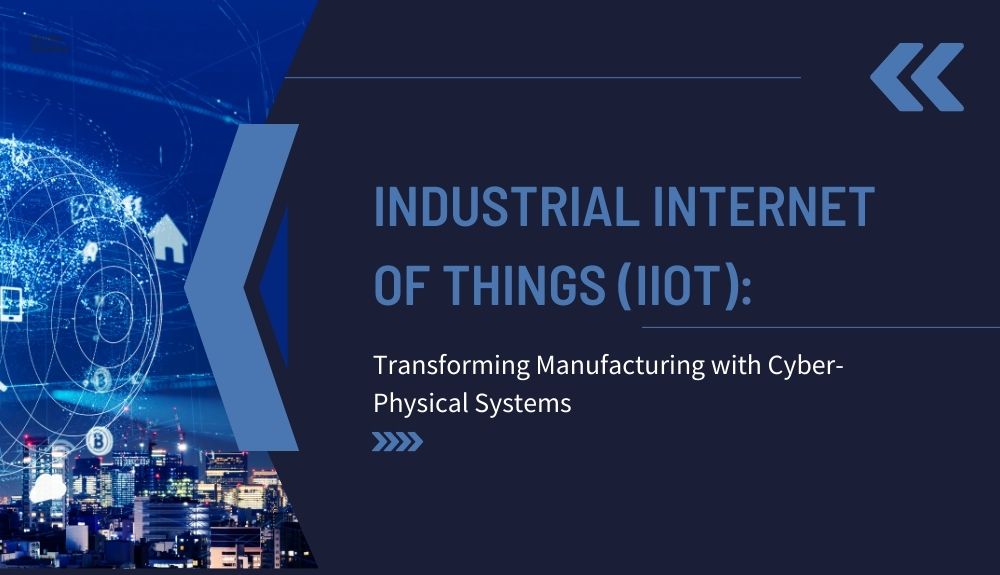Are you ready to witness the groundbreaking transformation that the Industrial Internet of Things (IIoT) is orchestrating in the manufacturing landscape? Imagine a world where machines communicate seamlessly, making real-time decisions and revolutionizing production processes. This futuristic reality is closer than you think, thanks to the integration of cyber-physical systems in manufacturing.
🌐 Dive into our blog to unravel the mysteries behind IIoT and cyber-physical systems. Discover how this synergy is reshaping traditional manufacturing into smart, interconnected ecosystems that drive efficiency and productivity.
🔧 Uncover the benefits and challenges of adopting IIoT in smart manufacturing, explore real-world applications, and delve into captivating case studies that showcase the tangible impact of this technology.
Ready to explore the next frontier in industrial innovation? Join us as we navigate through the intricate realms of IIoT and cyber-physical systems to unlock a future where possibilities are limitless.
Introduction to Industrial Internet of Things (IIoT) and Smart Manufacturing
The Industrial Internet of Things (IIoT) is revolutionizing the manufacturing industry by enabling a new era of connectivity and automation. It refers to the integration of physical devices, sensors, and machines with internet connectivity and data analytics capabilities. This powerful combination allows for the seamless exchange of information, real-time monitoring, and intelligent decision-making, leading to improved operational efficiency and productivity.
Smart manufacturing, also known as Industry 4.0, is the concept of using advanced technologies like the IIoT to create intelligent and interconnected manufacturing systems. These systems leverage cyber-physical systems (CPS) to bridge the gap between physical processes and digital information, resulting in enhanced process controls, predictive maintenance, and optimized resource allocation.
The benefits of adopting IIoT and smart manufacturing are numerous. Manufacturers can achieve higher levels of automation, reducing manual labor and human error while increasing efficiency. Real-time data collection and analysis enable predictive maintenance, allowing companies to identify potential machine failures before they occur, minimizing downtime and maintenance costs. Furthermore, smart manufacturing facilitates better decision-making through data-driven insights, leading to improved quality control and higher customer satisfaction.
In conclusion, the integration of IIoT and the concept of smart manufacturing is transforming the manufacturing industry, enabling businesses to streamline operations, enhance productivity, and stay competitive in the rapidly evolving digital landscape. By leveraging the power of connected devices and data analytics, manufacturers can unlock new opportunities for growth and innovation.
Understanding Cyber-Physical Systems (CPS)
Cyber-Physical Systems (CPS) represent the integration of computing, communication, and control systems with the physical processes involved in manufacturing. In the context of smart manufacturing, CPS are at the core of enabling the Industrial Internet of Things (IIoT) by connecting the digital realm of information technology with the physical world of machinery and production systems.
CPS are characterized by their ability to collect and analyze real-time data from physical devices, such as sensors and actuators, and use this information to inform decision-making processes. By combining hardware, software, and networking capabilities, CPS create a seamless and interconnected ecosystem where machines, humans, and processes work together to achieve enhanced efficiency and productivity.
One of the primary goals of integrating CPS with the IIoT in smart manufacturing is to enable real-time monitoring and control of the production process. Through the use of sensors embedded in machinery and equipment, manufacturers can gather valuable data on factors such as temperature, pressure, vibration, and energy consumption. This data is then transmitted to a central control system and analyzed to identify patterns, deviations, and potential issues. Based on this analysis, immediate adjustments and optimizations can be made to ensure optimal performance and prevent costly downtime.
Moreover, CPS enhance the decision-making capabilities of manufacturing systems. By leveraging the power of advanced analytics and machine learning algorithms, CPS can analyze large volumes of data generated by the IIoT to provide valuable insights and predictive models. This enables manufacturers to make data-driven decisions, optimize resource allocation, and improve overall operational efficiency.
Furthermore, CPS facilitate the automation and optimization of complex production processes. By integrating Industrial Internet of Things (IIoT) technologies such as connectivity, data exchange, and cloud computing, CPS enable the creation of intelligent manufacturing systems. These systems can autonomously control and coordinate the various components of a production line, dynamically adapting to changing conditions and demands.
In conclusion, the integration of cyber-physical systems with the Industrial Internet of Things (IIoT) is revolutionizing the manufacturing industry by enabling smart manufacturing. CPS play a crucial role in enhancing efficiency and productivity by connecting physical processes with digital intelligence. Through real-time data collection, analysis, and decision-making, CPS empower manufacturers to optimize their production systems, reduce costs, and stay competitive in the evolving industrial landscape.
Evolution of the Fourth Industrial Revolution

The Fourth Industrial Revolution represents a significant shift in the manufacturing industry, characterized by the convergence of digital technologies with physical systems. This revolution has paved the way for the emergence of the Industrial Internet of Things (IIoT) and the integration of cyber-physical systems (CPS) in manufacturing.
Historically, the first industrial revolution brought mechanization through the use of water and steam power. The second industrial revolution introduced mass production and assembly lines, powered by electricity. The third industrial revolution marked the advent of automation and computerization in manufacturing processes. Now, with the fourth industrial revolution, we are witnessing a new era of connectivity and intelligence.
Technological advancements, such as the proliferation of internet connectivity, the rise of cloud computing, and the development of powerful data analytics tools, have played a pivotal role in driving the integration of CPS and Industrial Internet of Things (IIoT). These advancements have enabled the seamless exchange of information between physical components and digital systems, leading to enhanced efficiency, productivity, and decision-making capabilities in smart manufacturing environments.
The Industrial Internet of Things (IIoT) has empowered manufacturers to harness data from sensors, machines, and other connected devices to gain valuable insights, optimize production processes, and enable predictive maintenance. The integration of cyber-physical systems in manufacturing practices has transformed traditional factories into intelligent systems that adapt and learn from real-time data.
As the fourth industrial revolution unfolds, industries are adapting to this new paradigm to stay competitive. Manufacturers are embracing the potential of CPS and IIoT to drive innovation and achieve new levels of operational excellence. By leveraging these technologies, businesses can unlock the full potential of automation, connectivity, and intelligent analytics to create smart digital factories capable of meeting the evolving demands of the market.
In summary, the evolution of the fourth industrial revolution, coupled with technology advancements, has ushered in the era of the Industrial Internet of Things (IIoT) and the integration of cyber-physical systems in manufacturing. This transformative combination is revolutionizing the industry, improving efficiency, and shaping the future of smart manufacturing.
Benefits of Integrating CPS with IIoT in Smart Manufacturing
The integration of cyber-physical systems (CPS) with the Industrial Internet of Things (IIoT) offers numerous advantages and potential benefits for the manufacturing industry. By combining these technologies, manufacturers can greatly enhance their operational efficiency, enable predictive maintenance, and make more informed and data-driven decisions.
Improved Operational Efficiency
The integration of CPS with Industrial Internet of Things (IIoT) allows for enhanced visibility and control over manufacturing processes. By connecting physical devices, sensors, and machines to the Internet, manufacturers gain real-time insights into the performance and status of their production systems. This real-time data enables proactive monitoring, optimization, and fine-tuning of manufacturing operations. By identifying inefficiencies, bottlenecks, and areas of improvement, manufacturers can streamline their processes, reduce downtime, minimize waste, and improve overall operational efficiency.
Predictive Maintenance
CPS and IIoT integration enables predictive maintenance practices in smart manufacturing. By leveraging real-time data from connected devices, manufacturers can monitor the health and performance of equipment, detect anomalies, and predict potential failures before they occur. This proactive approach to maintenance helps prevent costly unplanned downtime and allows for planned maintenance activities, reducing maintenance costs and improving overall equipment effectiveness.
Enhanced Decision-Making
With the vast amount of data generated by CPS and Industrial Internet of Things (IIoT) systems, manufacturers can make more informed and data-driven decisions. By analyzing real-time and historical data, manufacturers can gain valuable insights into production trends, machine performance, quality control, and supply chain management. These insights enable manufacturers to optimize production schedules, allocate resources effectively, improve product quality, and respond quickly to market demands. Data-driven decision-making leads to improved competitiveness, cost savings, and better customer satisfaction.
By integrating CPS with IIoT, manufacturers can unlock the full potential of Industry 4.0. Improved operational efficiency, predictive maintenance, and enhanced decision-making capabilities are just some of the benefits this integration offers. As smart manufacturing continues to evolve, embracing CPS and Industrial Internet of Things (IIoT) technologies becomes essential for manufacturers looking to stay competitive in the ever-changing industrial landscape.
Challenges and Limitations of Implementing CPS and IIoT in Manufacturing
When it comes to implementing cyber-physical systems (CPS) and the Industrial Internet of Things (IIoT) in smart manufacturing, there are several challenges and limitations that need to be considered. These hurdles can impact the successful integration and adoption of these technologies within the manufacturing industry. Some of the key challenges and limitations include:
1. Security Concerns
One of the primary challenges of implementing CPS and Industrial Internet of Things (IIoT) in manufacturing is ensuring the security of connected systems and data. With increased connectivity comes an increased risk of cyber threats and attacks. Manufacturers need to invest in robust cybersecurity measures to protect against unauthorized access, data breaches, and sabotage.
2. Data Privacy
The collection and sharing of data in smart manufacturing raise concerns about privacy. The vast amount of data generated by CPS and Industrial Internet of Things (IIoT) devices can contain sensitive information about products, processes, and even individuals. Manufacturers must establish comprehensive data privacy policies and practices to ensure compliance with regulations and protect the privacy rights of stakeholders.
3. Interoperability
Interoperability refers to the ability of different systems and devices to seamlessly communicate and work together. Implementing CPS and IIoT in manufacturing often involves integrating a variety of technologies, software systems, and equipment from multiple vendors. Achieving interoperability among these diverse components can be a significant challenge, requiring standardized protocols and interfaces.
4. Workforce Training
The successful implementation of CPS and IIoT in manufacturing requires a skilled workforce capable of managing and utilizing these technologies effectively. However, there is a shortage of professionals with the necessary expertise in CPS and IIoT. Manufacturers must invest in training programs to bridge the skills gap and ensure that their employees can maximize the benefits of these technologies.
It is important to address these challenges and limitations to fully harness the potential of CPS and IIoT in smart manufacturing. By prioritizing security, data privacy, interoperability, and workforce training, manufacturers can overcome these hurdles and unlock the transformative power of these technologies.
Future Trends and Emerging Technologies in CPS and IIoT for Smart Manufacturing

As the manufacturing industry continues to evolve in the era of Industry 4.0, the integration of cyber-physical systems (CPS) with the Industrial Internet of Things (IIoT) is opening up new possibilities and paving the way for future advancements. Several emerging technologies are playing a key role in shaping the future of CPS and IIoT in smart manufacturing.
Artificial Intelligence (AI) and Machine Learning (ML)
Artificial Intelligence and Machine Learning are at the forefront of driving innovation in smart manufacturing. By leveraging AI and ML algorithms, manufacturers can gain valuable insights from the massive amounts of data generated by IIoT devices. These technologies enable predictive and prescriptive analytics, facilitating proactive decision-making and optimizing various aspects of production processes. AI-powered solutions can detect anomalies, predict maintenance needs, and optimize resource allocation, ultimately improving operational efficiency and reducing downtime.
Edge Computing
As IIoT devices generate large volumes of data in real-time, the reliance on cloud-based solutions for data processing and analysis may lead to latency and bandwidth limitations. Edge computing addresses this challenge by bringing computing capabilities closer to the data source. With edge computing, manufacturers can process critical data locally, enabling faster response times, reducing latency, and improving overall system performance. This technology allows for real-time data analysis and decision-making, enhancing operational efficiency and enabling near-instantaneous adjustments in manufacturing processes.
Robotics and Automation
Advancements in robotics and automation are revolutionizing the manufacturing industry, leading to increased productivity and efficiency. Collaborative robots, also known as cobots, are designed to work alongside human operators, facilitating safer and more optimized forms of labor. These robots can handle repetitive and physically demanding tasks, freeing up human workers to focus on more complex and value-added activities. Additionally, AI-powered robots can adapt to changing production requirements, ensuring flexibility and agility in the manufacturing process.
Advanced Connectivity and Network Technologies
The seamless integration of different devices and systems within the IIoT ecosystem requires robust and reliable network infrastructure. Advanced connectivity technologies, such as 5G, offer high-speed, low-latency communication capabilities, enabling real-time data transmission and facilitating the interconnectedness of various components in smart manufacturing. Additionally, software-defined networking (SDN) platforms provide centralized control and management of network resources, enhancing scalability, security, and flexibility.
Cybersecurity and Data Management
As the reliance on CPS and IIoT grows, ensuring the security and integrity of data becomes paramount. Manufacturers need robust cybersecurity measures to protect their digital assets, including sensitive production and customer data. Moreover, effective data management strategies are crucial for deriving meaningful insights from the vast amount of data generated by IIoT devices. Data storage, integration, and analysis solutions enable manufacturers to harness the power of data-driven decision-making and optimize their operations.
The future of CPS and IIoT in smart manufacturing is marked by continuous innovation and the integration of advanced technologies. Artificial intelligence, edge computing, robotics and automation, advanced connectivity, and cybersecurity will play critical roles in shaping the manufacturing landscape of tomorrow. By embracing these emerging trends, manufacturers can unlock new levels of operational efficiency, productivity, and competitiveness in the evolving industrial landscape.
Conclusion
In conclusion, the integration of cyber-physical systems with the Industrial Internet of Things (IIoT) has the potential to revolutionize the manufacturing industry. By harnessing the power of smart digital technology, businesses can optimize their production processes and gain a competitive edge in the evolving industrial landscape.
Throughout this article, we have explored the concept of smart manufacturing and the role of the IIoT in enabling its realization. We have discussed the benefits and challenges associated with integrating cyber-physical systems in this context. The advantages of this integration include improved operational efficiency, predictive maintenance capabilities, and enhanced decision-making. However, challenges such as security, data privacy, interoperability, and workforce training must be addressed for successful implementation.
Real-world use cases have demonstrated how companies leverage CPS and IIoT to optimize production, improve quality control, and enhance supply chain management. Looking to the future, emerging technologies such as artificial intelligence, machine learning, and edge computing are set to further enhance the potential of CPS and IIoT in smart manufacturing.
Embracing these transformative technologies is crucial for businesses to stay competitive and thrive in the fourth industrial revolution. By adopting cyber-physical systems and embracing the IIoT, manufacturers can unlock new levels of efficiency, productivity, and innovation. It is evident that the era of smart manufacturing has arrived, and those who seize the opportunities it presents will lead the way in shaping the future of industrial production.



